
Porcelain is a ceramic material made by heating raw materials, generally including kaolinite, in a kiln to temperatures between 1,200 and 1,400 °C. The greater strength and translucence of porcelain, relative to other types of pottery, arise mainly from vitrification and the formation of the mineral mullite within the body at these high temperatures. End applications include tableware, decorative ware such as figurines, toilets and washbasins, and products in technology and industry such as electrical insulators and laboratory ware.

Josiah Spode was an English potter and the founder of the English Spode pottery works which became famous for the high quality of its wares. He is often credited with the establishment of blue underglaze transfer printing in Staffordshire in 1781–84, and with the definition and introduction in c. 1789–91 of the improved formula for bone china which thereafter remained the standard for all English wares of this kind.

Creamware is a cream-coloured refined earthenware with a lead glaze over a pale body, known in France as faïence fine, in the Netherlands as Engels porselein, and in Italy as terraglia inglese. It was created about 1750 by the potters of Staffordshire, England, who refined the materials and techniques of salt-glazed earthenware towards a finer, thinner, whiter body with a brilliant glassy lead glaze, which proved so ideal for domestic ware that it supplanted white salt-glaze wares by about 1780. It was popular until the 1840s.

"Blue and white pottery" covers a wide range of white pottery and porcelain decorated under the glaze with a blue pigment, generally cobalt oxide. The decoration is commonly applied by hand, originally by brush painting, but nowadays by stencilling or by transfer-printing, though other methods of application have also been used. The cobalt pigment is one of the very few that can withstand the highest firing temperatures that are required, in particular for porcelain, which partly accounts for its long-lasting popularity. Historically, many other colours required overglaze decoration and then a second firing at a lower temperature to fix that.

Bone china is a type of vitreous, translucent pottery, the raw materials for which include bone ash, feldspathic material and kaolin. It has been defined as "ware with a translucent body". It has been defined as "ware with a translucent body" containing a minimum of 30% of phosphate derived from calcined animal bone or calcium phosphate. Bone china is amongst the strongest of whiteware ceramics, and is known for its high levels of whiteness and translucency. Its high strength allows it to be produced in thinner cross-sections than other types of whiteware. Like stoneware, it is vitrified, but is translucent due to differing mineral properties.

Transfer printing is a method of decorating pottery or other materials using an engraved copper or steel plate from which a monochrome print on paper is taken which is then transferred by pressing onto the ceramic piece. Pottery decorated using this technique is known as transferware or transfer ware.
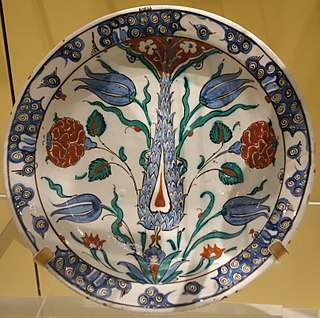
Underglaze is a method of decorating pottery in which painted decoration is applied to the surface before it is covered with a transparent ceramic glaze and fired in a kiln. Because the glaze subsequently covers it, such decoration is completely durable, and it also allows the production of pottery with a surface that has a uniform sheen. Underglaze decoration uses pigments derived from oxides which fuse with the glaze when the piece is fired in a kiln. It is also a cheaper method, as only a single firing is needed, whereas overglaze decoration requires a second firing at a lower temperature.
The Spode Museum is based in Stoke-on-Trent, England, where Josiah Spode, known for his role in the Industrial Revolution, established his pottery business in 1774. The Spode Museum collection includes a ceramics collection representing 200 years of Spode manufacture, ranging from spectacular pieces made for Royalty, the Great Exhibitions and the very rich to simple domestic wares.
Portmeirion is a British pottery company based in Stoke-on-Trent, England. They specialise in earthenware tableware.
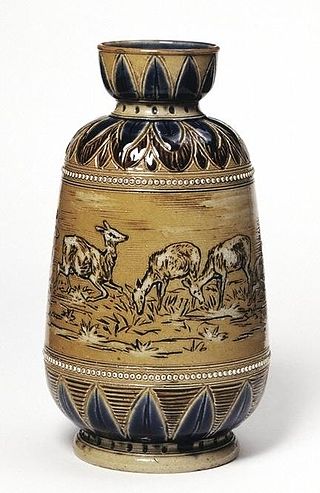
Royal Doulton is an English ceramic and home accessories manufacturer that was founded in 1815. Operating originally in Vauxhall, London, and later moving to Lambeth, in 1882 it opened a factory in Burslem, Stoke-on-Trent, in the centre of English pottery. From the start, the backbone of the business was a wide range of utilitarian wares, mostly stonewares, including storage jars, tankards and the like, and later extending to drain pipes, lavatories, water filters, electrical porcelain and other technical ceramics. From 1853 to 1901, its wares were marked Doulton & Co., then from 1901, when a royal warrant was given, Royal Doulton.

Thomas Minton (1765–1836) was an English potter. He founded Thomas Minton & Sons in Stoke-on-Trent, Staffordshire, which grew into a major ceramic manufacturing company with an international reputation.

The Willow pattern is a distinctive and elaborate chinoiserie pattern used on ceramic tableware. It became popular at the end of the 18th century in England when, in its standard form, it was developed by English ceramic artists combining and adapting motifs inspired by fashionable hand-painted blue-and-white wares imported from Qing dynasty China. Its creation occurred at a time when mass-production of decorative tableware, at Stoke-on-Trent and elsewhere, was already making use of engraved and printed glaze transfers, rather than hand-painting, for the application of ornament to standardized vessels.
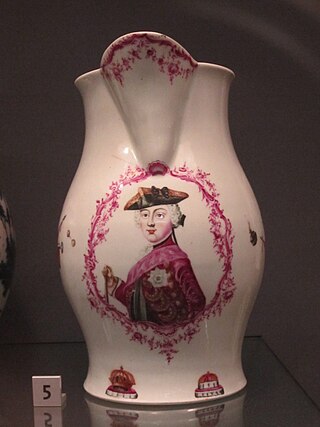
Liverpool porcelain is mostly of the soft-paste porcelain type and was produced between about 1754 and 1804 in various factories in Liverpool. Tin-glazed English delftware had been produced in Liverpool from at least 1710 at numerous potteries, but some then switched to making porcelain. A portion of the output was exported, mainly to North America and the Caribbean.
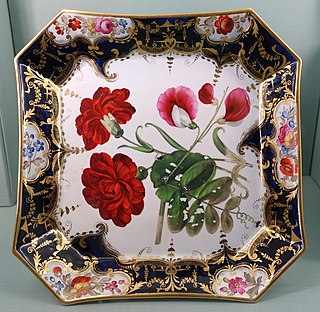
Coalport, Shropshire, England was a centre of porcelain and pottery production between about 1795 and 1926, with the Coalport porcelain brand continuing to be used up to the present. The opening in 1792 of the Coalport Canal, which joins the River Severn at Coalport, had increased the attractiveness of the site, and from 1800 until a merger in 1814 there were two factories operating, one on each side of the canal, making rather similar wares which are now often difficult to tell apart.

The Ridgway family was one of the important dynasties manufacturing Staffordshire pottery, with a large number of family members and business names, over a period from the 1790s to the late 20th century. In their heyday in the mid-19th century there were several different potteries run by different branches of the family. Most of their wares were earthenware, but often of very high quality, but stoneware and bone china were also made. Many earlier pieces were unmarked and identifying them is difficult or impossible. Typically for Staffordshire, the various businesses, initially set up as partnerships, changed their official names rather frequently, and often used different trading names, so there are a variety of names that can be found.
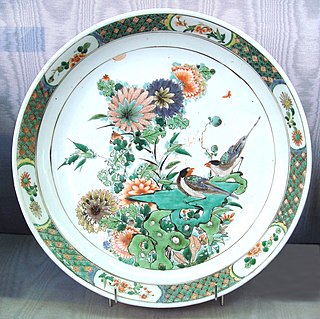
China painting, or porcelain painting, is the decoration of glazed porcelain objects such as plates, bowls, vases or statues. The body of the object may be hard-paste porcelain, developed in China in the 7th or 8th century, or soft-paste porcelain, developed in 18th-century Europe. The broader term ceramic painting includes painted decoration on lead-glazed earthenware such as creamware or tin-glazed pottery such as maiolica or faience.
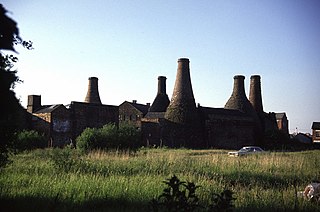
A potbank is a colloquial name for a pottery factory in North Staffordshire used to make bone china, earthenware and sanitaryware.

Ceramic art is art made from ceramic materials, including clay. It may take varied forms, including artistic pottery, including tableware, tiles, figurines and other sculpture. As one of the plastic arts, ceramic art is a visual art. While some ceramics are considered fine art, such as pottery or sculpture, most are considered to be decorative, industrial or applied art objects. Ceramic art can be created by one person or by a group, in a pottery or a ceramic factory with a group designing and manufacturing the artware.

Leeds Pottery, also known as Hartley Greens & Co., is a pottery manufacturer founded around 1756 in Hunslet, just south of Leeds, England. It is best known for its creamware, which is often called Leedsware; it was the "most important rival" in this highly popular ware of Wedgwood, who had invented the improved version used from the 1760s on. Many pieces include openwork, made either by piercing solid parts, or "basketwork", weaving thin strips of clay together. Several other types of ware were produced, mostly earthenware but with some stoneware.

The Turner family of potters was active in Staffordshire, England 1756-1829. Their manufactures have been compared favourably with, and sometimes confused with, those of Josiah Wedgwood and Sons. Josiah Wedgwood was both a friend and a commercial rival of John Turner the elder, the first notable potter in the family.
























